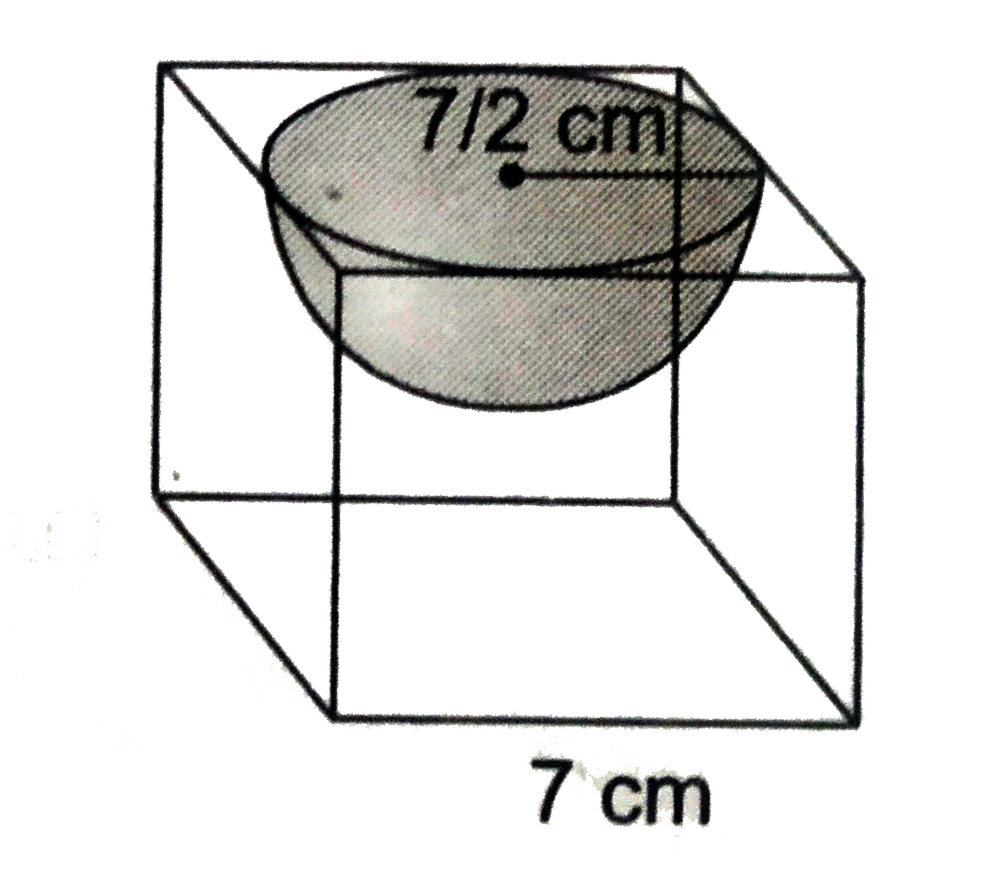A hemispherical depression is cut out from one face of a cubical block of side 7cm, such that the diameter of the hemisphere is equal to the edge of the cube. Find the surface area of the remaining solid.
422cm2
322cm2
326cm2
328cm2
The correct Answer is:B
Edge of the cube a = 7 cm
Radius of the hemisphere , r=7/2 cm
surface area of remaining solid
= total surface area of the cube -area of the top of hemisphercal part + curved suface area of the hemisphercal
=6a2−πr2+2πr2=6a2+πr2
=(6×7×7+227×72×72)cm2
=(294+38.5)cm2=332.5cm2

Topper's Solved these Questions
- VOLUME AND SURFACE AREAS OF SOLIDSBook:RS AGGARWALChapter:VOLUME AND SURFACE AREAS OF SOLIDSExercise:VOLUME AND SURFACE AREA OF A COMBINATION OF SOLIDS (SOLVED EXAMPLES )
Explore 2 Videos
- VOLUME AND SURFACE AREAS OF SOLIDSBook:RS AGGARWALChapter:VOLUME AND SURFACE AREAS OF SOLIDSExercise:Exercise 17A
Explore 28 Videos
- TRIGONOMETRIC RATIOS OF COMPLEMENTARY ANGLES Book:RS AGGARWALChapter:TRIGONOMETRIC RATIOS OF COMPLEMENTARY ANGLES Exercise:Exercise 12
Explore 15 Videos
Similar Questions
A hemispherical depression is cut out from one face of a cubical wooden block such that the diameter lof the hemisphere is equal to the edge of the cube. Determine the surface area of the remaining solid.
View SolutionA hemispherical depression is cut out from one face of a cubical wooden block such that the diameter ‘l’ of the hemisphere is equal to the edge of the cube. Determine the surface area of the remaining solid.
View SolutionA hemispherical depression is cut-out from one face of the cubical wooden block such that the diameter l of the hemisphere is equal to the edge of the cube. Determine the surface area of the remaining solid.
View SolutionA hemispherical depression is cut out from one face of a cubical wooden plank such that the diameter 4 of the hemisphere is equal to the edge of the cube. Determine the surface area of remaining solid.
View SolutionA hemispherical depression is cut out from one face of a cubical wooden block of edge 21 cm, such that the diameter of the hemisphere is equal to the edge of the cube. Determine the volume and total surface area of the remaining block.
View SolutionA cubical block of side 7 cm is surmounted by a hemisphere. What is the greatest diameter the hemisphere can have? Find the surface area of the solid.
View SolutionFrom a cubical piece of wood of side 21 cm, a hemisphere is carved out in such a way that the diameter of the hemisphere is equal to the side of the cubical piece. Find the surface area and volume of the remining piece.
View SolutionA cubical block of side 7 cm is surmounted by a hemisphere. What is the greatest diameter of the hemisphere can have? Find the total surface area of the solid.
View SolutionA cubical block of side 7 cm is surmounted by a hemisphere. What is the greatest diameter the hemisphere can have? Find the surface area of the solid.
View SolutionThe largest cone is curved out from one face of solid cube of side 21 cm find the volume of the remaining solid.
View Solution
